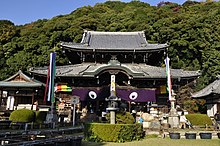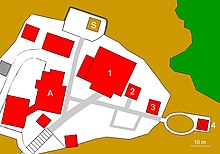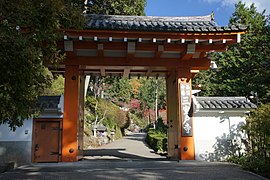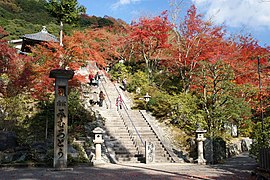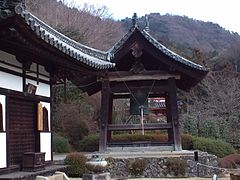Mimuroto-ji
The Mimuroto-ji ( Japanese 三室 戸 寺 ) with the mountain name Myōsei-san ( 明星 山 ) is a special temple of the Honzan Shugen-shū, which combines the Tendai direction of Buddhism with the Bergasket practices of Shugendō . The temple is located in Uji ( Kyoto Prefecture ), Japan and is the 10th temple on the Saigoku Pilgrimage Route by traditional counting .
history
According to tradition , a place of prayer was built during the Hōki era (770-781) for a thousand-armed Kannon that was found in the upper reaches of the Shizu River ( 志 津 川 -gawa ). The temple is said to have been moved to its current location later. After a decline, the temple was rebuilt by Priest Ryūmei ( 隆明 ; 1019-1104) from Onjō-ji in 1099 and became the 10th station of the Saigoku pilgrimage.
The attachment
You enter the temple complex at the foot of the hill through the temple gate ( 総 門 Sōmon ) and cross a park-like complex with flower beds and a rock garden. Then you climb a long staircase to the inner complex, which is framed by the rock walls of Mount Myōsei (Myōsei-san; brown in the plan).
The current main hall ( 本 堂 Hondō ; 1 in plan) was completed in 1814. The "Amida Hall" ( 阿 弥陀 堂 Amida-dō ; 2) dates from 1714, the bell tower ( 鐘楼 Shōrō ; 3) is from 1689. The three-story pagoda ( 三重 塔 Sanjū-no-tō ; 4) was built by the Kōzō -ji ( 高 蔵 寺 ) in Hyōgo Prefecture moved here in 1704.
The independent shrine Jūhachi main shrine ( 十八 神社 本 殿 Jūhachi-jinja honden ) from 1487 is designed in the style of a "three- fathom shrine" ( 三 間 社 流 造 Sangen sharyū-zukuri ). It is registered as an Important Cultural Asset of Japan .
To the west of the upper temple area is the abbot and monk's quarters (A).
Temple treasures
In the treasure house of the temple are u. a. to see:
- The standing Shaka Nyorai ( 木造 釈 迦 如 来 立 像 Mokuzō Shaka Nyorai ritsuzō ) made of wood comes from the late Heian period . It is the oldest existing copy in the style of Seiryū-ji in Kyoto ,
- the seated Amida Nyorai made of wood with two companions ( 木造 阿 弥陀 如 来 及 び 両 脇 侍坐 像 Mokuzō Amida Nyorai oyobi ryōkyōji zazō ) and
- made of wood, holy Bishamon ( 毘 沙門 天 立 像 Bishamon-ten ritsuzō ).
All sculptures are from the late Heian period and are registered as Important Cultural Property of Japan.
photos
literature
- Kyoto-fu rekishi isan kenkyukai (Ed.): Mimuroto-ji . In: Kyoto-fu no rekishi sampo (ge). Yamakawa Shuppan, 2011. ISBN 978-4-634-2 4826-7 .
Web links
- Website of the temple
- Bernhard Peter: Uji (Kyoto Prefecture), Mimuroto-ji
Coordinates: 34 ° 54 ′ 1.7 ″ N , 135 ° 49 ′ 9.1 ″ E
